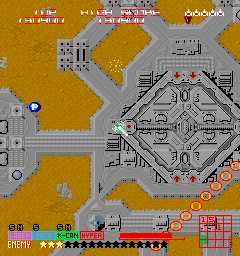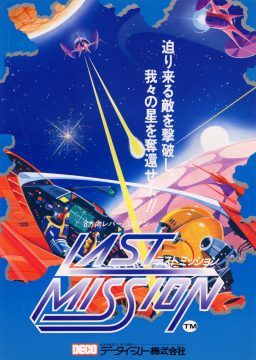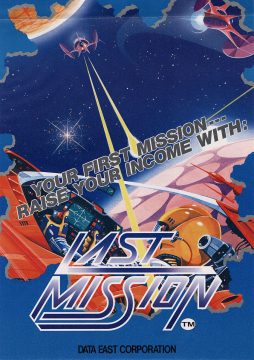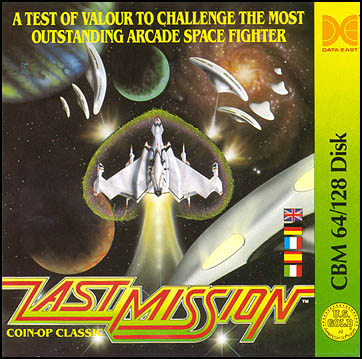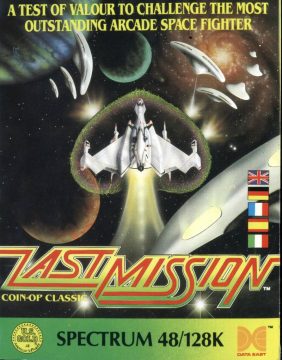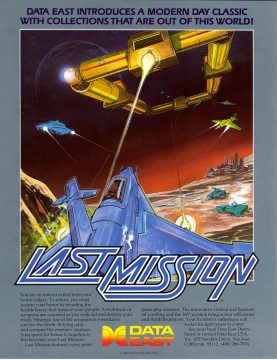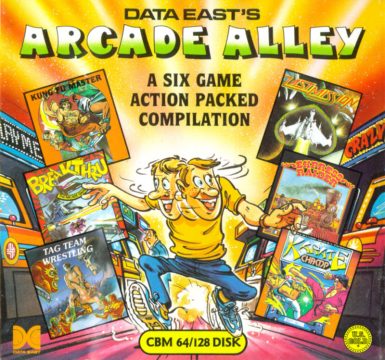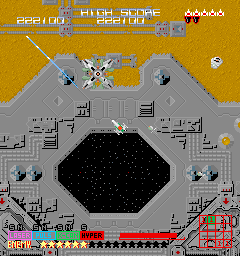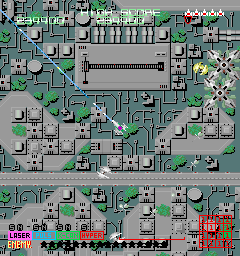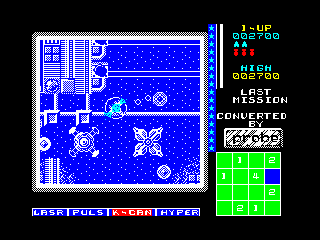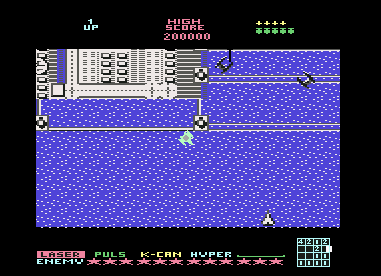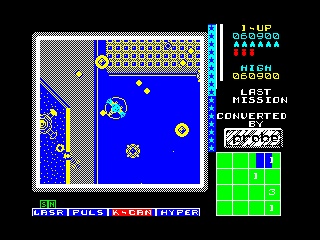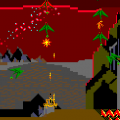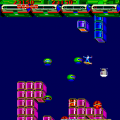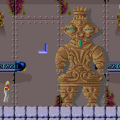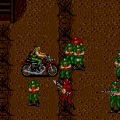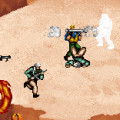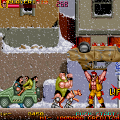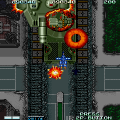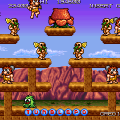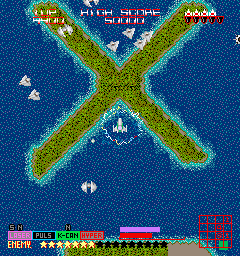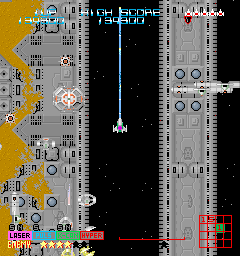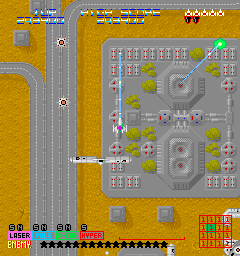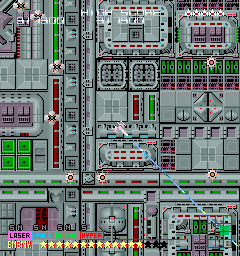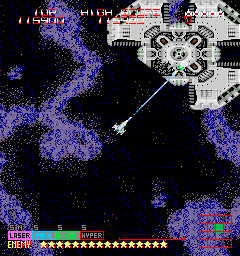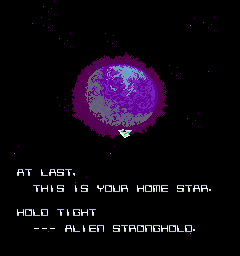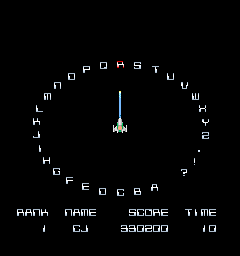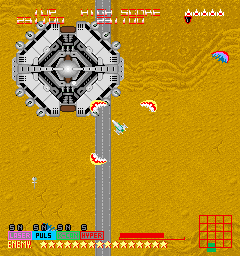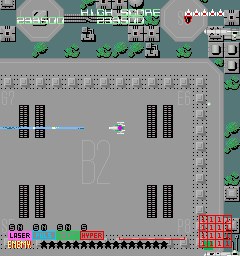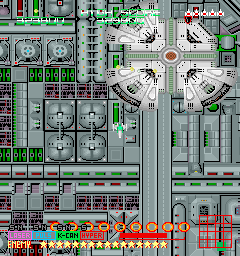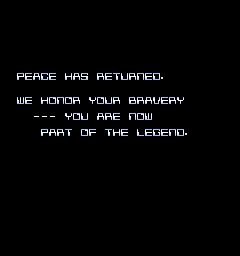Last Mission is another long forgotten Data East game. This one is a take on overhead shooters like Thunder Force, Vanguard II, and Time Pilot ’84. While those earlier games offer understandably little for the time in the way of a story or context for the action, Last Mission gives players a quick blurb (in accurate English compared to later Data East games like Atomic Runner Chelnov) before starting the game proper:
TAKE THE CHALLENGE
FROM THE ALIENS WHO HAVE
INVADED YOUR HOME STAR.
RECOVER THE STAR
FROM THEIR PAWS.
THIS IS YOUR LAST MISSION.
But when the game was released outside of Japan, some subtle changes were made:
YOU ARE AN OUTCAST…..
RESTORE YOUR HONOR…..
INVADE THE HOSTILE FORCES
WHO TORMENT YOUR PEOPLE.
YOUR QUEST FOR
HONOR IS YOUR…..
LAST MISSION.
What started out as a mission to rescue one’s home has been changed to read like someone’s dying request that the player initiates an invasion to save face and exact revenge. It’s a weird change since the original game is already in English, and is an unusual alteration for a 1986 shooter when everything else about the game is identical in all regions. While players never get to actually see the person piloting the ship or who they are fighting for, the ship itself is reminiscent of the one from Data East’s 1981 shooter Astro Fantasia. That game is running on much weaker hardware, but it actually has a similar structure, with the player having to shoot down a number of waves of invading enemies before the game’s villain, Astarogon, descends to fight the player directly. Going by Last Mission’s introduction blurbs, however, it looks like the invasion is already complete.
It may seem like drawing blood from a stone to try to extract any plot or characterization from a 1986 overhead shooter, but it was obviously a high priority for designer Akira Sakuma since Last Mission‘s introduction CANNOT BE SKIPPED. One must watch this tale of exiles and revenge slowly type out across the screen every time one starts a new game. It’s also just as well since it’s one of the only things about the game that actually sets it apart from its contemporaries. Everything else about the game is unfortunately much less interesting. Last Mission‘s backgrounds seem intricate at a glance, but they’re very blandly colored, with the game’s first level being its visual peak. The enemies are also indistinct, and this applies to most of the game’s bosses as well. This wouldn’t be so bad if not for the very large amount of them that must be defeated before a boss will show up. The enemies are numerous, and take only a few hits to defeat, but their designs are universally boring. Even if the background graphics were more interesting it would not make up for this. The game’s generally bland soundtrack doesn’t help either. Azusa Hara worked on this game as sound programmer, but we will see a massive jump in quality in Data East’s arcade game soundtracks when she takes a more active role as a composer in games like Heavy Barrel and Atomic Runner Chelnov.
One much appreciated feature of the game is the grid map at the bottom of the screen. It shows the number of larger enemies in each part of the level. Blowing up these larger craft will reveal power up items that can be picked up to offer a variety of weapons for player’s ship. Each of these weapons is impressively efficient at eliminating enemy ships, but ammunition is limited, and must be restored by picking up more items from those larger foes. Besides the laser players start out with by default, three more are available and the player can cycle through them at will. Unfortunately since each weapon has its own pool of ammunition, one has to constantly cycle through them to ensure that which ever one they’re lowest on is the one equipped when they pick up a refill. For a game that throws large amounts of both enemies and firepower at the player, it can be frustrating to run out of ammunition just before a boss fight. The game is designed assuming it will be consuming a large amount of quarters, as those power up-bearing ships all reappear every time the player loses a life, and if the player loses a life during a boss fight, they’re required to destroy a small amount of enemies again in hopes of getting some more weapons before the boss will reappear.
Besides having buttons for selecting and firing weapons, a third button will let players a bomb that will clear the entire screen of enemies. This can be useful on parts of the map with several larger enemies on it, but are better saved for the bosses fought at the end of each level. While it’s tempting to use them in the level proper, enemies tend to reappear quickly enough that these massive explosions don’t offer the breathing room one might expect, and it ends up being much more efficient to use them all at once to quickly destroy the giant ships found at the end of the stage. The bosses themselves are generally uninteresting, with most of them being variations on a large flying saucer. The boss of level two, however, is excellent. It’s a giant rectangular space station that teleports in around the player. To defeat it several points inside it must be destroyed, but some fancy flying is required also to navigate outside and around it to target its final weak points as well. Unfortunately none of the game’s other climatic battles reach this level of creativity.
While Last Mission‘s stale presentation failed to set the arcades on fire, a year later Data East still chose to have it released on the Commodore 64 and ZX Spectrum along with several other games they distributed in arcades like Ikari Warriors. While both ports (these are completely unrelated to the Opera Soft game known as The Last Mission, also from 1987) can of course not approach the arcade game’s graphics and sound, the Spectrum release is an admirable effort. Converted by Probe, the limitations of the ZX Spectrum have resulted in a rebalanced and more approachable game. Despite the choppier scrolling and simplified backgrounds, the number of enemies confronting the player isn’t dramatically smaller, while the amount of firepower they throw at the player actually matches the arcade game. All of the weapons can be upgraded further than they could in the original as well, making it easier to conserve ammunition as they become much more efficient at destroying multiple enemies with a single shot. There’s no music in the game proper, but this is just as well given the generally uninteresting soundtrack it had in the arcades. Despite the alterations, it’s an impressive conversion for how much of the arcade game’s visuals and pacing it manages to retain.
The Commodore 64 release is a bit less successful. An attempt was made to very accurately depict Last Mission‘s arcade experience, resulting in many of the same issues seen in Firebird’s Commodore 64 conversion of Flying Shark. Incoming projectiles and enemy movements can be very difficult to see. It can also be difficult to control, as on the Commodore 64 the ship is steered by having keys for “rotate left” and “rotate right” instead of the more traditionally direct control seen in the arcades. In attempting to be so close to the arcade game, Keith Purkiss’ conversion of Last Mission also inherits the original’s flaws. Though unlike on the ZX Spectrum it does offer a simple but nice rendition of the game’s first level background music while actually playing, courtesy of David Whittaker.
Commodore 64 fans and critics were generally unimpressed with the conversion. In a Zzap!64 review in their October 1987 issue, two of their three critics couldn’t stand it. Amusingly, however, something everyone seems to have to loathed the most at the time is having to endure that unskippable text blurb about restoring one’s honor every time a new game begins. Either way, when Data East released a compilation of their games for both systems called Data East’s Arcade Alley, Last Mission was among the chosen games for both releases.
Last Mission‘s simplicity doesn’t hold up well in the face of its competition, with Thunder Force II offering a similar experience with a superior presentation, and Vanguard II accomplishing more on much older hardware. Still, Thunder Force II clearly took a cue from both of these earlier games’ weapons and art design, and Last Mission would turn out to be an important stepping stone for Data East. While it would be one of the only games worked on by Akira Sukama and Yuji Gondo, several of its staff would set the stage for Data East’s future with Heavy Barrel that same year. Last Mission‘s production ended up helping what would become much of Data East’s core talent for the 80s and early 90s hone their skills, with several like Michiya Hirasawa and Tatsuo Yamaguchi playing a role in a wide range of games from The Combatribes to Mystic Ark to Mobile Suit Gundam: Crossfire. Last Mission is an unremarkable game, but a competently made one that ended up being a precursor to Data East’s big hits of the late 80s.
